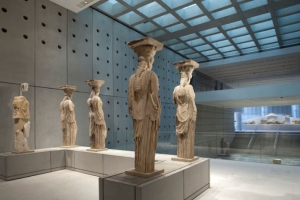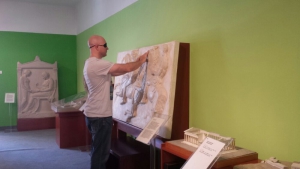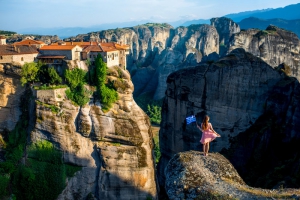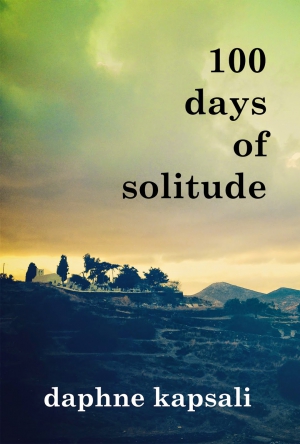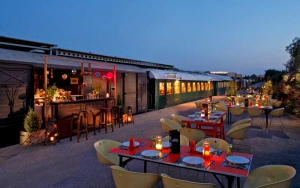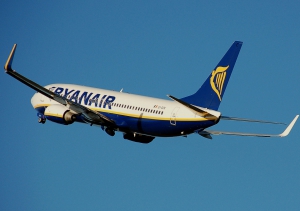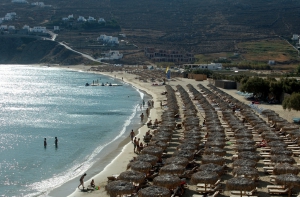BUSINESS CENTRE
XpatAthens
Monday, 06 March 2017 07:00
The Amazing Whistle Language Of Greece
What if there was a language that only uses whistling for communication and conversation and no words? There is such a language and it exists in Greece.
It is not just about plain whistling sounds or signals, but an actual conversational whistle language!
Sometimes, by meeting people out of the blue and talking to them, you may discover amazing secret hidden gems of culture. When Greek Adventure travelled to South Evia they discovered this Greek secret.
The village this secret is hidden in is called Andia and is located at South Evia, near Cape Cavo D’ Oro. Apparently there is a whistle language used, which has a label by itself. It is called 'Sfyria.' The reason this was born? The locals say they wanted to use a way to communicate across the countryside from long distances. Others claim that it was used to alert people about incoming bandits. Sound travels fast, especially in the wilderness and tops of Greek mountains, so a whole whistle conversational language was born.
The existence of the whistling language of Andia was discovered after an airplane accident happened in the area in 1979. The pilot was missing and search parties went to the area. There, the locals offered their help and they used the 'Sfyria' whistling to communicate across the mountains. No mobiles in 1979!
To read this article in full, please visit: A Greek Adventure
Published in
Greek Language & Culture
Tagged under
Friday, 19 June 2015 07:00
The Acropolis Museum Turns 6!
As part of celebrations for its sixth birthday, the Acropolis Museum will launch a series of exhibitions featuring archaeological treasures from small museums across Greece, with “Samothrace – The Mysteries of the Great Gods” on June 20, 2015.
On the same day, a concert in the museum courtyard will feature the Athens Municipality Philharmonic Orchestra and Choir in works from the interwar period, the cinema and Greek operetta. All exhibition areas and the restaurant will remain open from 8am to midnight and admission will be reduced at 3 euros for all visitors.
On June 21, the museum will organize a scientific conference focusing on recent archaeological research in Samothrace.
Organized in collaboration with ephorates of Rodopi and Evros,under the guidance Samothrace antiquities expert Dimitrios Matsas,the temporary show features 252 ancient artefacts assembled in groups on the basis of their relationship to the island’s sanctuary, where visitors were initiated into the island cult. The exhibit will run through to September 30.
To read more please visit: Greek Travel Pages
Published in
Local News
Tagged under
Thursday, 18 June 2015 12:01
Tactual Museum Athens
What is a Tactual Museum exactly? Read on to find out more.
When Dave Briggs drew the Tactual Museum of Athens as the next museum on his list to visit, he was excited. He'd heard of tactual museums, but had never visited one before. The basic concept is that they are set up as a way for sighted people to experience and understand to a small degree what it must be like to operate in a world without sight. The idea is to be led around a room blindfolded, and then to touch a series of objects in order to understand what they might be.
The Tactual Museum in Athens
The Museum does this with a difference. Rather than using ordinary objects, they instead display copies of artifacts from Ancient Greece. The idea behind this is twofold. Firstly, non-sighted people rarely, if ever, get to touch and feel the relics from an ancient past. These faithful replicas would allow them to do so. Secondly, it would give a chance for sighted people to approach ancient Greece from a new angle, and experience trying to work out what a new object is just by the sense of touch. People are given blindfolds to experience the museum as a non-sighted person would.
There were two rooms downstairs, and several larger rooms upstairs. Some of the smaller objects, such as the golden laurel leaf crown, were especially hard to work out what they were.
Location:
Visitors’ entrance via Lighthouse for The Blind of Greece
Athinas 17, Kallithea, 17673
Hours:
8:00 - 17:00
Museum Website: http://www.tactualmuseum.gr/indexe.htm
Location:
Visitors’ entrance via Lighthouse for The Blind of Greece
Athinas 17, Kallithea, 17673
Hours:
8:00 - 17:00
Museum Website: http://www.tactualmuseum.gr/indexe.htm
To read this article in full please visit: Dave's Travel Pages
Published in
City Discovery
Tagged under
Friday, 19 June 2015 07:00
Tripadvisor: The Ten Best Historic Sites In Greece
These are the top ten sights and landmarks not to be missed in Greece according to the users of Tripadvisor. Based on the votes of travelers themselves, Tripadvisor has come up with a list of the top ten sights and landmarks worth visiting in Greece.
Rather unsurprisingly the top two places go to Greece's most recognizable landmark with the Acropolis hill taking the first spot followed by the Parthenon itself at number 2.
The list also includes Meteora, Delphi and perhaps lesser known monuments such as the Acropolis of Rhodes and the island of Spinalonga which was once home to a leper colony.
Below is the list in full of the top ten places to visit in Greece:
Νο 1 Acropolis
Νο 2 Parthenon - One of the seven wonders of the ancient world
Νο 3 Meteora - The monasteries perched on the tops of imposing cliffs are wonders in their own right and marvels of Byzantine architecture
Νο 4 Delphi - Perhaps the spiritually most important site of the ancient world
Νο 5 Hephaestus Temple in Athens - The best preserved ancient Greek temple in Athens and perhaps the country
To read more, please visit: The TOC
Published in
Travel Greece
Tagged under
Thursday, 18 June 2015 07:00
100 Days Of Solitude - Daphne Kapsali
How far do you need to go to find yourself?
What do you have to give up?
Daphne didn't go very far. After too many years of living as a writer who didn't write, she gave up her life in London to spend 100 days of solitude on the remote Greek island of Sifnos, off season, and find out, once and for all, who she really was. Her challenge: to write every day.
One hundred days and one hundred entries later, her question had been answered in more ways than she could have imagined, and the things she'd given up never mattered in the first place. This book is her story, as personal as it is universal, of the most obvious and most fundamental quest of all: to be happy; to do what you love.
Part memoir, part fiction, part philosophy and part travel writing, 100 days of solitude is a collection of one hundred stories, all of them connected and each one self-contained.
To find out more about this book, please visit Daphne's site at: Daphne Kapsali
Available on Amazon
Published in
Books
Tagged under
Thursday, 18 June 2015 07:00
Apovathra Open Air Bar
Discover “Apovathra”, the outdoor platform of the Railway Carriage Theater to Treno sto Rouf, at Rouf railway station, only ten minutes from the lively Gazi district.
Enjoy refreshing cocktails, delicious Greek snacks, hip DJ sounds, art exhibitions, video screenings and live musical performances. Escape to the coolest spot of the city during summer.
Enjoy the atmosphere among the blooming oleanders and the subdued lighting from the train carriages of the unique Railway Theater.
Address:
“Rouf” Railway Station on Konstantinoupoleos Ave., 11854. (Map: https://goo.gl/maps/0eiDx)
Enjoy refreshing cocktails, delicious Greek snacks, hip DJ sounds, art exhibitions, video screenings and live musical performances. Escape to the coolest spot of the city during summer.
Enjoy the atmosphere among the blooming oleanders and the subdued lighting from the train carriages of the unique Railway Theater.
Address:
“Rouf” Railway Station on Konstantinoupoleos Ave., 11854. (Map: https://goo.gl/maps/0eiDx)
For more, please visit: To Treno Sto Rouf
Published in
Pubs, Bars & Cafes
Tagged under
Thursday, 18 June 2015 07:00
Ryanair Extends Chania Routes To Athens And Thessaloniki In August
Ryanair has announced that it will increase the frequencies to flights on its Chania routes to Athens and Thessaloniki this August due to overwhelming demand, as part of its Chania summer 2015 schedule.
The flights from Chania to Athens will increase from three to four daily and to Thessaloniki will rise from one to two per day.
Ryanair’s Chania summer schedule also includes two new routes to Glasgow and Manchester (29 routes in total), and extra flights to Dublin. The airline expects the summer schedule to deliver one million passengers annually and support 1,000 on-site jobs at Chania Airport.
According to the airline, Greek customers and visitors can now choose from 29 routes to/from Chania this summer, while enjoying allocated seating, a free second carry-on bag, reduced fees, an improved website and app with mobile boarding passes, as well as Ryanair’s Family Extra and Business Plus services.
To read more, please visit: Greek Travel Pages
According to the airline, Greek customers and visitors can now choose from 29 routes to/from Chania this summer, while enjoying allocated seating, a free second carry-on bag, reduced fees, an improved website and app with mobile boarding passes, as well as Ryanair’s Family Extra and Business Plus services.
To read more, please visit: Greek Travel Pages
Published in
Greece In The News
Tagged under
Wednesday, 17 June 2015 14:26
Life's A Beach
It's hot. Finally. So hot that I'm complaining about it. This makes me happy. It also makes me want to pack it all in and plant myself on some hot sand somewhere, close enough to jump in the water when the sweat is just too much to bear.. Greek Summer is here!
'Are there beaches in Athens??' Why, yes, dear tourist. There are plenty. Some of them are even nice! And some others are... less nice.
Close to the city-centre, I've been to Akanthus a couple times. It is an 'all day beach bar' along the Alimos seaside - with a lovely sandy beach, clear waters, and a decidedly cool vibe. There is a restaurant with a nice menu, music all day long, and a nighttime club transformation on most nights. It gets rather busy, especially on weekends. But if you go early enough, it's one of the nicer spots close to the city.
There are many beaches along the Athenian Rivera (as entire coastal strip has been branded). The further south you go, the more crystal clear the water becomes, as the surroundings become less 'urban'. Or so one would think. There are some obvious places I would never (ever) swim - and plenty of others that would make me pause and think.
How is one to know about the cleanliness of the waters around Attica? There are a couple places to check for water quality. The Greek Centre for Environmental Research (ΠΑΚΟΕ - Πανελληνιο Κεντρο Οικολογικών Ερευνών) recently released its ratings of Attica's beaches, based on its scientific measurements of water quality. Some people have commented on the ratings, saying that they are biased - you can judge for yourselves.
For an alternative version, with interactive map, try the Clean Beaches site - outlined below (also in English).
Whatever you choose to believe, have your wits about you and don't bunk down in the first place with a sandy stretch of beach. Take good care and enjoy the summer!
Until next week,
Jack
Beach Report (ΠΑΚΟΕ)
(in Greek, but Google translate can help here - and most of the beach names can be easily recognized)
Clean Beaches
Akanthus
Leof. Poseidonos, Kalamaki, Athens
+30 210 968 0800
www.akanthus.grFor more on what beaches are not recommended for swimming in Athens click HERE.
For ideas on great beaches that are highly recommend for swimming in and around Athens click HERE.
Published in
My Week In Athens
Tagged under
Wednesday, 17 June 2015 07:00
Greek Spirits & Liqueurs ~ The Ultimate Mediterranean Aperitif
Their flavours are unique. Their essence feels like Greece and summertime. Ouzo, raki, tsipouro and masticha: among the wide selection of Greek products, three famous spirits and a liqueur are eager to reveal their secrets.
Greek Ouzo
Ouzo is considered the national drink of Greece. In technical terms ouzo is either produced by partial distillation or the admixture of plain alcohol with aromatic herbs. The best ouzos are of course the distilled ones with the main flavour being imparted by anise seeds, though other aromatics are often added, such as masticha from Chios, cinnamon, cloves or fennel, depending on the brand. Each location prides itself on its ouzo but the most famous are from the island of Lesvos and from Tyrnavos in Thessaly.
Ouzo is ideally served chilled, with or without ice, though many add water which releases the essential oils from the anise, turning the drink milky and heightening the aromas. You should always add ice or water to already poured ouzo and not the other way around.
Though ouzo is delightful with many kinds of traditional Greek meze, like a good ladotyri from Zakynthos or Mytilini or a kopanisti from Mykonos or Tinos, it is best known for its affinity for strong-flavoured seafood such as the octopus mentioned above or marinated anchovies. Spicy pickled peppers also go well.
Traditional Raki and Tsipouro
Apart from ouzo, Greece is known for another pair of considerably stronger distilled local drinks, often confused with one another, raki and tsipouro. Frequently homemade, production peaks in the autumn after the grape-harvest with celebrations centred around the great distillation cauldrons.
Tsipouro is a traditional product that comes from mainland Greece while raki is from Crete. Both are made from grapes not destined for wine-making yet still capable of producing quality distilled spirits. The main differences among them are the degree of alcoholic content and the addition or not of anise seed, which is often added to tsipouro but never to raki.
Tsipouro with anise has pride of place in the tsipouro bars of Volos where it accompanies traditional delicacies from the region and Thessaly in general. Drink it either chilled or with ice.
Potent raki is enjoyed by Cretans of all ages, usually in shot glasses either chilled or at room temperature. They tend to accompany it with traditional products of Crete like cheese, local preserved meats, roasts or whatever else arrives at table including traditional sweets and pies. No excuse is needed to pour a glass at any hour of the day or night.
To read more, please visit: Discover Greece
Published in
Greek Food & Diet
Tagged under
Wednesday, 17 June 2015 07:00
Tears As Greek State TV Returns To Air After Austerity Shutdown
Exactly two years after the state broadcaster was abruptly shut down by the previous government, ERT began broadcasting again in place of its successor NERIT.
Employees at Greece's state television ERT hugged each other and cried on Thursday 11th June 2015 as the channel aired its first broadcast in two years, after it was shut down under one of the previous government's most drastic austerity measures.
Leftist Prime Minister Alexis Tsipras, who is racing to reach a cash-for-reforms deal with the European Union and IMF, had called ERT's closure "a great wound" of his country's bailout. He made its reopening one of his priorities as part of efforts to roll back cuts demanded by the lenders.
Employees gathered on the set in the early hours of 11th June 2015 in tears as anchors prepared to present the first early-morning talk show. Ahead of the programme, the channel played out footage of some of Greece's most famous landmarks and scenery, as the national anthem blared out.
"It's a special day for all Greeks, for philhellenes, for those who love Greece and for those who love freedom of information," anchor Nikos Aggelidis said at the start of the show. "We're nervous. We're very touched."
Visibly moved, his co-presenter Vasiliki Haina added in a shaky voice: "It's a special day for us, a difficult day." The news ticker at the bottom of the screen read: "The return of ERT two years since the black."
To read more, please visit: The TOC
Published in
Local News
Tagged under



